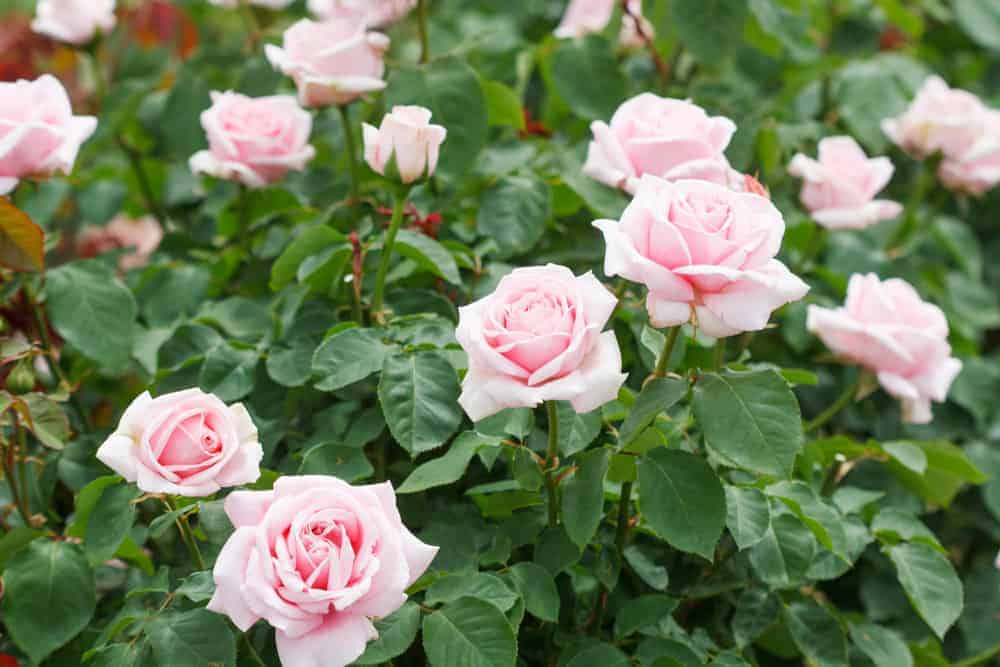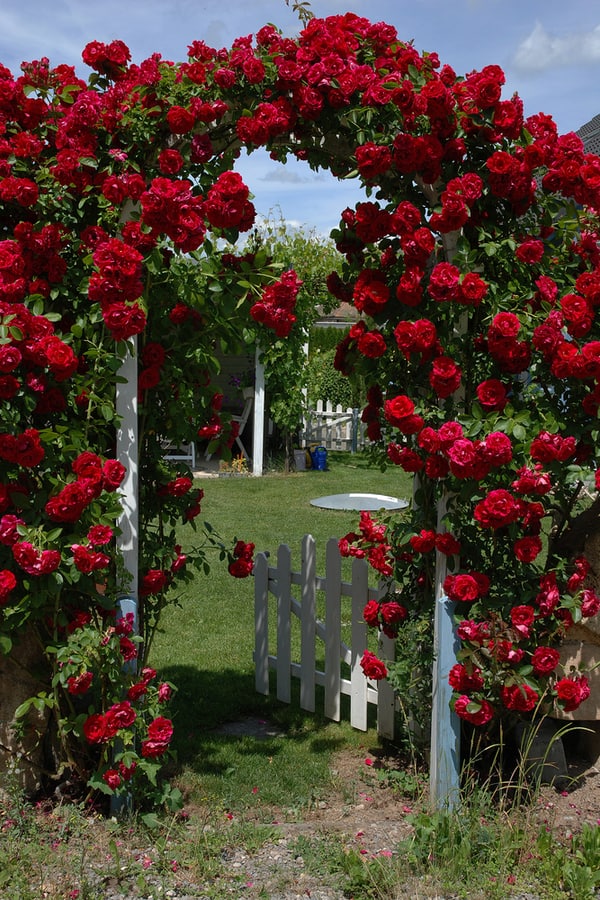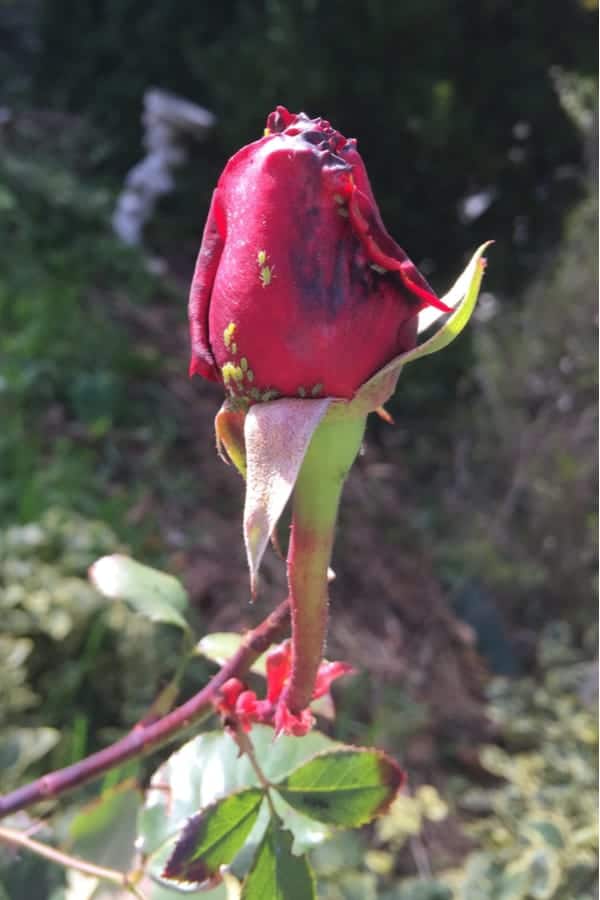There are over 300 species and a few thousands of cultivars of these woody perennials. They are probably the most popular flower in the world even though none of us enjoy their sharp prickles.
Most roses originated in Asia, but there are also cultivars native to North America, Europe, and even Africa. Once you establish the rose bushes in your garden, you will enjoy their blooms, which vary in color, size, and shape, over fifty years.
Types of Roses You Can Grow
Hybrid tea roses

Most of us have this type of roses in our gardens. They grow as a bush and have beautiful, large flowers on the straight, 4 to 6 feet (1.2 – 1.8 m) tall stems.
You will find three to four rose-buds on each stem. It’s up to you to leave all of them or to clip off secondary buds and keep just a central one to grow full, with a lot of layers of petals.
Climbing rose (Floribunda rose)

This type of rose makes vines and needs a trellis or fence to climb. If you leave this plant without adequate support, it will climb up for a while, fall over, and broke eventually.
Be prepared that climbing roses usually grow over 10 feet (3 m) high, which means that you need to find a proper place for them and adequate support as well.
I adore this type of roses because of a profusion of fragrant flowers all around. Their blooms don’t have the full look like hybrid teas, but a single circle of red, yellow, or white petals is absolutely adorable.
Miniature roses

These tiny roses are not popular like the previous two varieties, but you should consider purchasing some of them for your garden or even home.
They are an excellent choice for terraces, patios, and unique rock gardens with constrained space. Expect those flowers to grow about 1 to 3 feet (30.5 – 91.5 cm) in height, which means that you can also grow them in a container.
How to Plant Rose in Your Garden
Propagation
There are two effective ways to propagate your roses, by taking cuttings or by seed. Most gardeners take cuttings from their own, well-established bush while horticulturalists and commercial growers get new roses from seeds.
1. Growing roses from cuttings

The best time for this action is spring while the temperatures are still lower, and the rose bush is vigorous.
Start by selecting young, light green, tender shoots without buds, because they have the best chances to root well. Don’t try to use older and woody stems to avoid disappointment.
If the chosen shoot has a bud, you should snip it off. Then cut about 4 to 6 inches (10 – 15 cm) long piece, and plant it 1 to 2 inches (2.5 – 5 cm) deep in the weed-free ground. The best option is to place your new rose at the permanent place to avoid transplantation, which can affect your young plant negatively.
Water a new plant abundantly and cover it with a glass jar, which will have a role similar to mini-greenhouse. Under the jar, your rose will grow undisturbed, while getting ideal temperatures and enough humidity.
Unfortunately, the rate of cuttings that take root is usually meager, especially when a gardener is inexperienced. If you are one of them, try to start with three to four shoots for the first time.
Don’t disturb young cuttings, but you should check if the moisture of the soil is adequate. Do it every several days. Be careful when removing the jar since the roots of your new plant are quite shallow.
When the temperatures reach at least 75 F (24 C), you can let your rose uncovered during the day.
Be prepared to see the cuttings dormant for a while. I assure you, they just look like inactive. In fact, all the activity, including the essential development of the roots, happens underground.
Once roots are established, your shoots will start growing, usually a couple of weeks after planting. That is the moment when you can remove the jar permanently.
2. Growing roses from seeds

Even though most of us are not aware of that fact, roses can produce seeds. It is not a common way of propagating this flower, but you can always leave a spent rose on the stem.
Over time, there will form a rosehip (bulb) with seeds inside. After it dries entirely, you should pick it out and harvest seeds. Sow seeds indoors in early spring and remove them outdoors when the weather becomes warmer.
How to Care Rose in Your Garden
Space
You should avoid planting roses too near other plants because they can compete in water and sunlight. To get excellent results, you need to plant them at least 2 feet (61 cm) away from the next rose bush and 3 feet (91 cm) away from any other plant.
When deciding to add roses to your garden, you should make a good plan. Don’t plant these flowers under the trees or on the places exposed to wind. If the region you live in is too windy, roses will probably grow at an angle.
Soil
Your roses will thrive when the soil is fertile and loose, with a pH from 6.5 to 7. If the ground is poor, it is necessary to add some fertilizer because this lovely flower requires plenty of nutrients.
Light

Roses require at least 6 to 8 hours of direct sunlight a day. More sun they get more flowers they will produce. They can tolerate partial shade, but you can’t count on such a lush blooming in that case.
If you live in the northern States, you should plant your roses near a fence or wall on the south side of your garden. That will provide enough warmth to boost the production of flower and reduce possible damage during cold months.
Temperatures

Start planting your roses in the garden when the temperatures reach from 40 to 60 F (4.5 – 15. 5 C) during the day. On the other hand, the temperatures (except the extreme ones) won’t affect well-established roses.
Watering

The amount of water your roses need |
|
|
Shrub roses |
1 to 3 gallons (3.8 – 11 l) |
| Roses in pots |
1 to 3 gallons (3.8 – 11 l) |
|
Standard roses |
3 to 6 gallons (11 – 23 l) |
| Climbing roses |
3 to 6 gallons (11 – 23 l) |
|
Rambling roses |
3 to 6 gallons (11 – 23 l) |
Always adjust the level of watering, depending on the type of soil and climate. Keep your flowers moist, especially in the first summer, but never allow the soil to become too soggy. Reduce watering in autumn, but take care that the ground around your roses is never entirely dry.
Your flowers will prefer deep watering at the base of the stalk without getting the leaves wet. An adequate dripper system is an ideal solution to provide the necessary 8 inches (20 cm) of water twice a week.
You can also water your plants with a watering can or gardening hose, depending on the number of shrubs. Do it as close to the base of the stem as you can. Take a break to let the water soaks in, and keep watering until it is necessary.
Fertilizing
Never feed your roses at the time of planting. Once established, they will need regular fertilizing. The best option is adding organic fertilizer such as compost or mature manure, which will add necessary nutrients to the soil slowly but steady.
Keep in mind that artificial fertilizers, especially liquid ones, encourage tender growth. Consequently, new foliage often attracts pests, especially aphids. Instead, add 1 cup of 5-10-10 granular fertilizer around every bush monthly between April and July.
You can also put one banana peel at the base of each plant. It will provide enough calcium, magnesium, phosphates, and sulfur for your bush. Additionally, add some phosphorus for beautiful flourishing, and your roses will award you with the loveliest blooms you have ever wanted.
Mulching

Mulching is an excellent way to keep the soil around your roses moist and weed-free. You can mulch the garden whenever you have free time, but for best results, it is better to do the job in early spring.
Begin with removing the weeds. After that, place 1 inch (2.5 cm) thick layer of small bark chippings, grass clippings, or chopped leaves around roses.
Take care to keep them approximately 6 inches (15 cm) away from the base of the plant. If the ground is dry, you should water well over mulch at the end of the process.
Pruning

Be careful while pruning your roses because cutting the bush too much in autumn may irreversibly damage it. Instead, you should wait for mid-spring, when first leaf buds become visible.
You shouldn’t prune all types of roses in the same way, but one thing will apply to all of them. Always cut canes two-thirds of their height. The best way for pruning smaller ones is to cut them approximately 6 to 12 inches (15 – 30.5 cm) from the surface of the ground.
Deadheading

Most types of roses, especially the re-blooming ones, need deadheading after each flowering. By regular cutting of faded blossoms, you will encourage the production of new flowers throughout the season of flourishing.
Remove the withered flowers above the first leaflet until early fall. Take care to avoid damaging the foliage since it is a valuable source of energy, which allows the development of more flowers.
If you grow the type of Rose which blooms in clusters, you should remove a center bud. You will adore the result because you will get a natural bouquet without a hole in the middle of the cluster. Plus, this procedure will prevent common fungal infections.
The process is a bit different if you grow hybrid roses. In this case, you should remove the buds forming under the central flower bud. That way, you will help your rose bush to produce larger and more prominent flowers.
Rose Pests and Diseases
Some insects and pests can cause damage to your roses, but, fortunately, there are a lot of effective treatments against those causative agents. The essential thing is to start treating your flowers as soon as possible.
Aphids

These sucking bugs are the most common problem in the garden full of roses. You can find them attached to the stem of the plant and on the underside of its leaves.
After sucking the juices from the foliage, those creatures will cause weakening of your rose bush. Use insecticidal soap or an appropriate insecticide and eliminate this unpleasant issue.
Beetles

These insects attack the flowers until destroying them. The problem is that you can’t do much for the affected flower once you spot these creatures.
Help your plant by applying proper insecticides regularly. Planting garlic next to the rose bush may prevent the occurrence of these bugs.
Prevention of Common Disease
Adequate prevention will help your roses to grow strong and healthy. The best things you can do for your plants are to:
- Choose a sunny spot for growing your roses
- Add a proper amount of necessary fertilizer once a month
- Provide regular watering without wetting the foliage
- Prune rose bush regularly to provide adequate airflow
- Remove old and withered stems, flowers, and leaves

Leave a comment